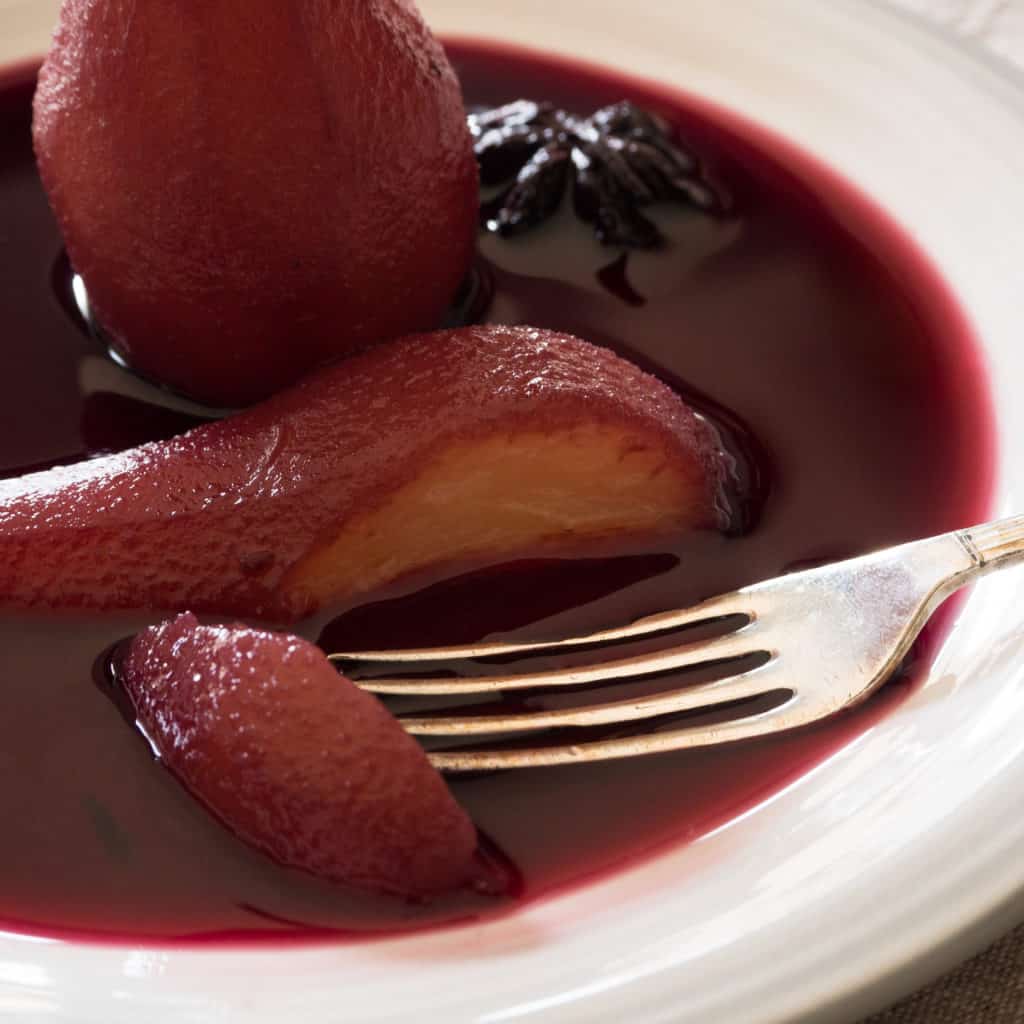
It is the height of summer (it is probably raining in London) and you want a dessert that is just a bit more grown up than gluten-free, vegan ice-cream or chocolate something… I can guarantee you these unctuous Pears Poached in Spiced Red Wine are super quick and super easy and a great way to make use of the gut of pears that often hits in the summer. This is a very mature (look at me I am fancy!) dessert and a great treat (show-off) when you have guests around for dinner. The once firm pears become yielding to the spoon and are a perfect after dinner treat. A great alternative to a rich cake or pudding.
The cooking liquid, reduced down to a rich syrup and passed through a sieve, is a delicious, rich, glossy sauce that you can serve with the pears warm or cold.
You can find the full Pears Poached in Spiced Red Wine recipe here.
Pears Poached in Spiced Red Wine go great with crumbled Crunchy Gluten-Free, Vegan, Ginger Oat Biscuits and a spoon of gluten-free, vegan ice-cream.
Preparation
Difficulty
Preparation time 5 minutes
Cooking time 40 minutes
You can find the full Pears Poached in Spiced Red Wine recipe here.
Allergens
Pears Poached in Spiced Red Wine are gluten-free and vegan as well as…
Celery free
Coconut free
Garlic free
Lupin free
Mustard free
Nightshade free
Onion free
Peanut free
Sesame free
Soya free
Tree nut free
About
Auguste Escoffier created Poire belle Hélène (named after the operetta La belle Hélène by Jacques Offenbach) around 1864. It is a dessert made from pears poached in sugar syrup and served with vanilla ice cream and chocolate syrup. Whether Escoffier really did create this (had no one ever eaten poached pears and ice-cream?), he adapted an existing dish or he just made it fancy – who knows! However poached pears a super popular.
One reason poached pears are so popular is that they make unripe pears edible and make firm pears soft and yielding. There are often gluts of fruit in summer and autumn and poaching them is a great way to eat them.
My preference for this dish are comice, conference or Williams pears – all cook well. Choose pears that are not quite ripe, this way they will not disintegrate on poaching.
The pear can be one of several tree and shrub species of genus pyrus in the family rosaceae. Pear is also the name of the pomaceous fruit of the trees. Several species of pear are valued for their edible fruit and juices, while others are cultivated as ornamental trees.
The pear is native to coastal and mildly temperate regions of western Europe and north Africa east and across Asia. Pear trees are medium-sized, reaching 10–17 metres in height, often with a tall, narrow crown. There are a few shrub species. Most pear trees are deciduous however, one or two species in southeast Asia are evergreen. Most trees are cold-hardy, withstanding temperatures between −25 °C and −40 °C in winter (except for the evergreen species, which only tolerate temperatures down to about −15 °C).
In most wild species of pear the fruit is one to four centimetres diameter however, in some cultivated forms the fruit is up to 18 centimetres long and 8 centimetres wide. The shape varies from round to the classic ‘pear-shape’ of the European pear. It is sometimes difficult to distinguish between pear and apple fruit: some pears look like some apples, e.g. the nashi pear. One major distinguishing factor is that the flesh of pear fruit contains stone cells (also called “grit”).
Evidence of pear cultivation has been found in prehistoric pile dwellings around Lake Zurich. The pear was also cultivated by the Romans, who ate the fruits raw or cooked, just like apples. Pliny’s Natural History recommended stewing them with honey and noted three dozen varieties. The Roman cookbook De re coquinaria has a recipe for a spiced, stewed-pear patina, or soufflé. Pears have been cultivated in China for approximately 3000 years.